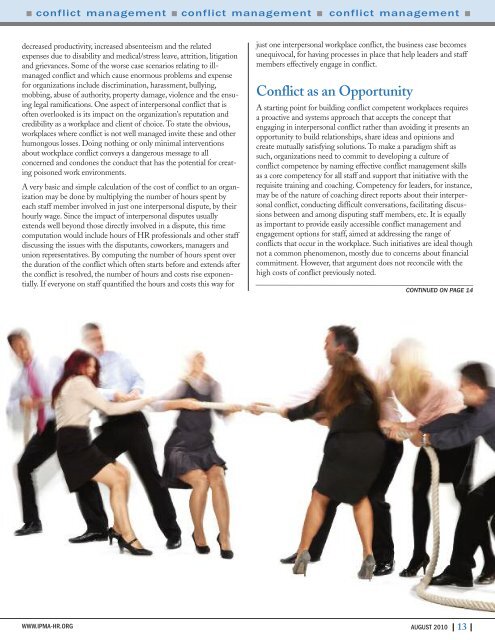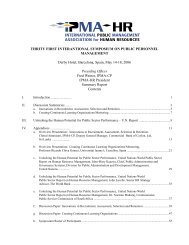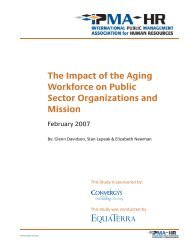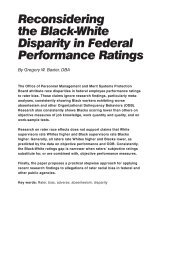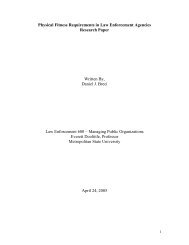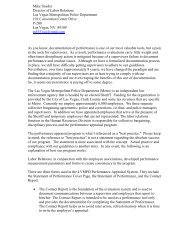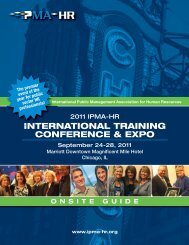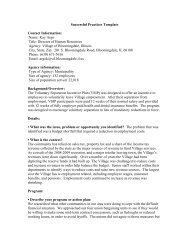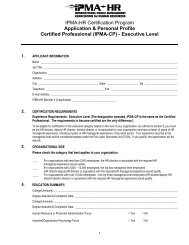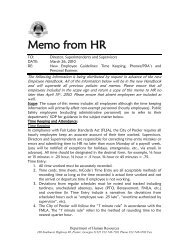Conflict Management Coaching - IPMA
Conflict Management Coaching - IPMA
Conflict Management Coaching - IPMA
Create successful ePaper yourself
Turn your PDF publications into a flip-book with our unique Google optimized e-Paper software.
■ conflict management ■ conflict management ■ conflict management ■<br />
decreased productivity, increased absenteeism and the related<br />
expenses due to disability and medical/stress leave, attrition, litigation<br />
and grievances. Some of the worse case scenarios relating to illmanaged<br />
conflict and which cause enormous problems and expense<br />
for organizations include discrimination, harassment, bullying,<br />
mobbing, abuse of authority, property damage, violence and the ensuing<br />
legal ramifications. One aspect of interpersonal conflict that is<br />
often overlooked is its impact on the organization’s reputation and<br />
credibility as a workplace and client of choice. To state the obvious,<br />
workplaces where conflict is not well managed invite these and other<br />
humongous losses. Doing nothing or only minimal interventions<br />
about workplace conflict conveys a dangerous message to all<br />
concerned and condones the conduct that has the potential for creating<br />
poisoned work environments.<br />
A very basic and simple calculation of the cost of conflict to an organization<br />
may be done by multiplying the number of hours spent by<br />
each staff member involved in just one interpersonal dispute, by their<br />
hourly wage. Since the impact of interpersonal disputes usually<br />
extends well beyond those directly involved in a dispute, this time<br />
computation would include hours of HR professionals and other staff<br />
discussing the issues with the disputants, coworkers, managers and<br />
union representatives. By computing the number of hours spent over<br />
the duration of the conflict which often starts before and extends after<br />
the conflict is resolved, the number of hours and costs rise exponentially.<br />
If everyone on staff quantified the hours and costs this way for<br />
WWW.<strong>IPMA</strong>-HR.ORG<br />
just one interpersonal workplace conflict, the business case becomes<br />
unequivocal, for having processes in place that help leaders and staff<br />
members effectively engage in conflict.<br />
<strong>Conflict</strong> as an Opportunity<br />
A starting point for building conflict competent workplaces requires<br />
a proactive and systems approach that accepts the concept that<br />
engaging in interpersonal conflict rather than avoiding it presents an<br />
opportunity to build relationships, share ideas and opinions and<br />
create mutually satisfying solutions. To make a paradigm shift as<br />
such, organizations need to commit to developing a culture of<br />
conflict competence by naming effective conflict management skills<br />
as a core competency for all staff and support that initiative with the<br />
requisite training and coaching. Competency for leaders, for instance,<br />
may be of the nature of coaching direct reports about their interpersonal<br />
conflict, conducting difficult conversations, facilitating discussions<br />
between and among disputing staff members, etc. It is equally<br />
as important to provide easily accessible conflict management and<br />
engagement options for staff, aimed at addressing the range of<br />
conflicts that occur in the workplace. Such initiatives are ideal though<br />
not a common phenomenon, mostly due to concerns about financial<br />
commitment. However, that argument does not reconcile with the<br />
high costs of conflict previously noted.<br />
CONTINUED ON PAGE 14<br />
AUGUST 2010 | 13 |


